
langgraph4j
🚀 LangGraph for Java. A library for building stateful, multi-actor applications with LLMs, built for work jointly with langchain4j
Stars: 365
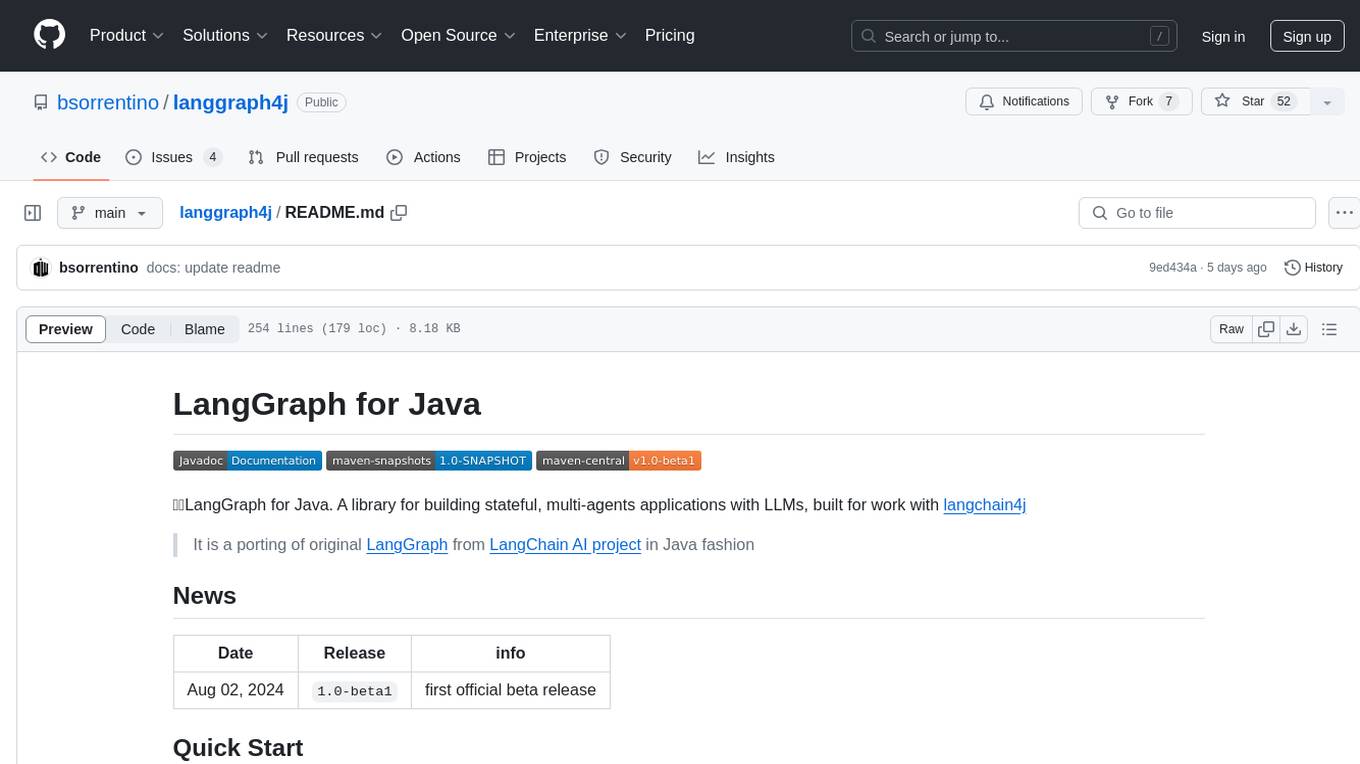
LangGraph for Java is a library designed for building stateful, multi-agent applications with LLMs. It is a porting of the original LangGraph from the LangChain AI project to Java. The library allows users to define agent states, nodes, and edges in a graph structure to create complex workflows. It integrates with LangChain4j and provides tools for executing actions based on agent decisions. LangGraph for Java enables users to create asynchronous node actions, conditional edges, and normal edges to model decision-making processes in applications.
README:
LangGraph for Java. A library for building stateful, multi-agents applications with LLMs, built for work with langchain4j
It is a porting of original LangGraph from LangChain AI project in Java fashion
- [x] StateGraph
- [x] Nodes
- [x] Edges
- [x] Conditional Edges
- [x] Entry Points
- [x] Conditional Entry Points
- [x] State
- [x] Schema (a series of Channels)
- [x] Reducer (how apply updates to the state attributes)
- [x] Default provider
- [x] Appender channel (values accumulator)
- [x] delete messages
- [x] Schema (a series of Channels)
- [x] Compiling graph
- [x] Async support (throught CompletableFuture)
- [x] Streaming support (throught java-async-generator)
- [x] Checkpoints (save and replay feature)
- [x] Graph visualization
- [x] Playground (Embeddable Webapp that plays with LangGraph4j)
- [x] Threads (checkpointing of multiple different runs)
- [x] Update state (interact with the state directly and update it)
- [x] Breakpoints (pause and resume feature)
- [x] Studio (Playground Webapp)
- [x] Spring Boot
- [x] Jetty
- [x] Quarkus
- [X] Streaming response from LLM results
- [X] Child Graphs
- [X] Parallel Node Execution
- With some constraints
- [X] Generator (Visual Builder)
Note:
From release 1.2.x the miminum supported Java version is the
Java 17and the artifactlanggraph4j-core-jdk8is replaced bylanggraph4j-core
| Date | Release | info |
|---|---|---|
| Apr 06, 2025 | 1.5.4 |
official release |
- How to add persistence ("memory") to your graph
- How to view and update past graph state
- How to parallel branch
- How to wait for user input
- How to sub-graph
- Use Case
| Project | Integrated With |
|---|---|
| Agent Executor | SpringAI |
| Agent Executor | Langchain4j |
| Image To PlantUML Diagram | Langchain4j |
| Adaptive RAG | Langchain4j |
Maven
<dependency>
<groupId>org.bsc.langgraph4j</groupId>
<artifactId>langgraph4j-core</artifactId>
<version>1.5.4</version>
</dependency>Maven
<dependency>
<groupId>org.bsc.langgraph4j</groupId>
<artifactId>langgraph4j-core</artifactId>
<version>1.5-SNAPSHOT</version>
</dependency>The main type of graph in langgraph is the StatefulGraph. This graph is parameterized by a state object that it passes around to each node.
Each node then returns operations to update that state. These operations can either SET specific attributes on the state (e.g. overwrite the existing values) or ADD to the existing attribute.
Whether to set or add is described in the state's schema provided to the graph. The schema is a Map of Channels, each Channel represent an attribute in the state. If an attribute is described with an AppendeChannel it will be a List and each element referring the attribute will be automaically added by graph during processing. The State must inherit from AgentState base class (that essentially is a Map wrapper).
public class AgentState {
public AgentState( Map<String,Object> initData ) { ... }
public final java.util.Map<String,Object> data() { ... }
public final <T> Optional<T> value(String key) { ... }
public final <T> T value(String key, T defaultValue ) { ... }
public final <T> T value(String key, Supplier<T> defaultProvider ) { ... }
}We now need to define a few different nodes in our graph. In langgraph, a node is an async/sync function that accept an AgentState as argument and returns a (partial) state update. There are two main nodes we need for this:
- The agent: responsible for deciding what (if any) actions to take.
- A function to invoke tools: if the agent decides to take an action, this node will then execute that action.
/**
* Represents an asynchronous node action that operates on an agent state and returns state update.
*
* @param <S> the type of the agent state
*/
@FunctionalInterface
public interface AsyncNodeAction<S extends AgentState> extends Function<S, CompletableFuture<Map<String, Object>>> {
CompletableFuture<Map<String, Object>> apply(S t);
/**
* Creates an asynchronous node action from a synchronous node action.
*/
static <S extends AgentState> AsyncNodeAction<S> node_async(NodeAction<S> syncAction) { ... }
}We will also need to define some edges. Some of these edges may be conditional. The reason they are conditional is that based on the output of a node, one of several paths may be taken. The path that is taken is not known until that node is run (the LLM decides).
-
Conditional Edge: after the agent is called, we should either:
- If the agent said to take an action, then the function to invoke tools should be called
- If the agent said that it was finished, then it should finish
- Normal Edge: after the tools are invoked, it should always go back to the agent to decide what to do next
/**
* Represents an asynchronous edge action that operates on an agent state and returns a new route.
*
* @param <S> the type of the agent state
*/
public interface AsyncEdgeAction<S extends AgentState> extends Function<S, CompletableFuture<String>> {
CompletableFuture<String> apply(S t);
/**
* Creates an asynchronous edge action from a synchronous edge action.
*/
static <S extends AgentState> AsyncEdgeAction<S> edge_async(EdgeAction<S> syncAction ) { ... }
}We can now put it all together and define the graph! (see example below)
Like default use case proposed in LangGraph blog, We have converted AgentExecutor implementation from langchain using LangGraph4j. In the agent-executor project's sample, there is the complete working code with tests. Feel free to checkout and use it as a reference.
Below you can find a piece of code of the AgentExecutor to give you an idea of how is has built in langgraph style.
/**
* Represents the state of an agent.
*/
class State extends MessagesState<ChatMessage> {
public State(Map<String, Object> initData) {
super(initData);
}
public Optional<String> finalResponse() {
return value("agent_response");
}
}
var toolNode = ToolNode.builder()
.toolSpecification( tools )
.build();
var agent = Agent.builder()
.chatLanguageModel(chatLanguageModel)
.tools(toolNode.toolSpecifications())
.build();
var callAgent = new CallAgent(agent);
var executeTools = new ExecuteTools(agent, toolNode);
// Fluent Interface
var app = new StateGraph<>(State.SCHEMA, State::new)
.addEdge(START,"agent")
.addNode("agent", node_async(callAgent))
.addNode("action", node_async(executeTools))
.addConditionalEdges(
"agent",
edge_async( state ->
state.finalResponse()
.map(res -> "end")
.orElse("continue");
),
Map.of("continue", "action", "end", END)
)
.addEdge("action", "agent")
.compile();
return app.stream( inputs );For Tasks:
Click tags to check more tools for each tasksFor Jobs:
Alternative AI tools for langgraph4j
Similar Open Source Tools

langgraph4j
LangGraph for Java is a library designed for building stateful, multi-agent applications with LLMs. It is a porting of the original LangGraph from the LangChain AI project to Java. The library allows users to define agent states, nodes, and edges in a graph structure to create complex workflows. It integrates with LangChain4j and provides tools for executing actions based on agent decisions. LangGraph for Java enables users to create asynchronous node actions, conditional edges, and normal edges to model decision-making processes in applications.
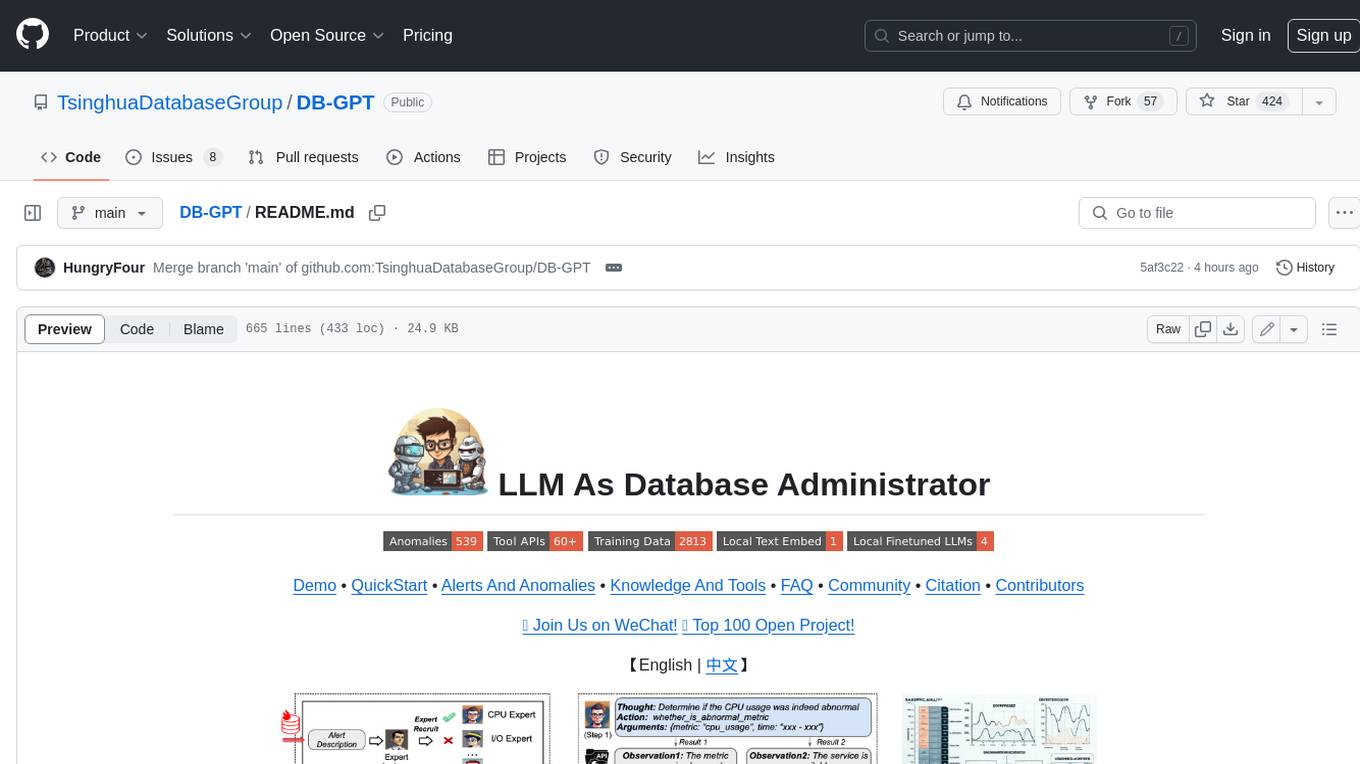
DB-GPT
DB-GPT is a personal database administrator that can solve database problems by reading documents, using various tools, and writing analysis reports. It is currently undergoing an upgrade. **Features:** * **Online Demo:** * Import documents into the knowledge base * Utilize the knowledge base for well-founded Q&A and diagnosis analysis of abnormal alarms * Send feedbacks to refine the intermediate diagnosis results * Edit the diagnosis result * Browse all historical diagnosis results, used metrics, and detailed diagnosis processes * **Language Support:** * English (default) * Chinese (add "language: zh" in config.yaml) * **New Frontend:** * Knowledgebase + Chat Q&A + Diagnosis + Report Replay * **Extreme Speed Version for localized llms:** * 4-bit quantized LLM (reducing inference time by 1/3) * vllm for fast inference (qwen) * Tiny LLM * **Multi-path extraction of document knowledge:** * Vector database (ChromaDB) * RESTful Search Engine (Elasticsearch) * **Expert prompt generation using document knowledge** * **Upgrade the LLM-based diagnosis mechanism:** * Task Dispatching -> Concurrent Diagnosis -> Cross Review -> Report Generation * Synchronous Concurrency Mechanism during LLM inference * **Support monitoring and optimization tools in multiple levels:** * Monitoring metrics (Prometheus) * Flame graph in code level * Diagnosis knowledge retrieval (dbmind) * Logical query transformations (Calcite) * Index optimization algorithms (for PostgreSQL) * Physical operator hints (for PostgreSQL) * Backup and Point-in-time Recovery (Pigsty) * **Continuously updated papers and experimental reports** This project is constantly evolving with new features. Don't forget to star ⭐ and watch 👀 to stay up to date.
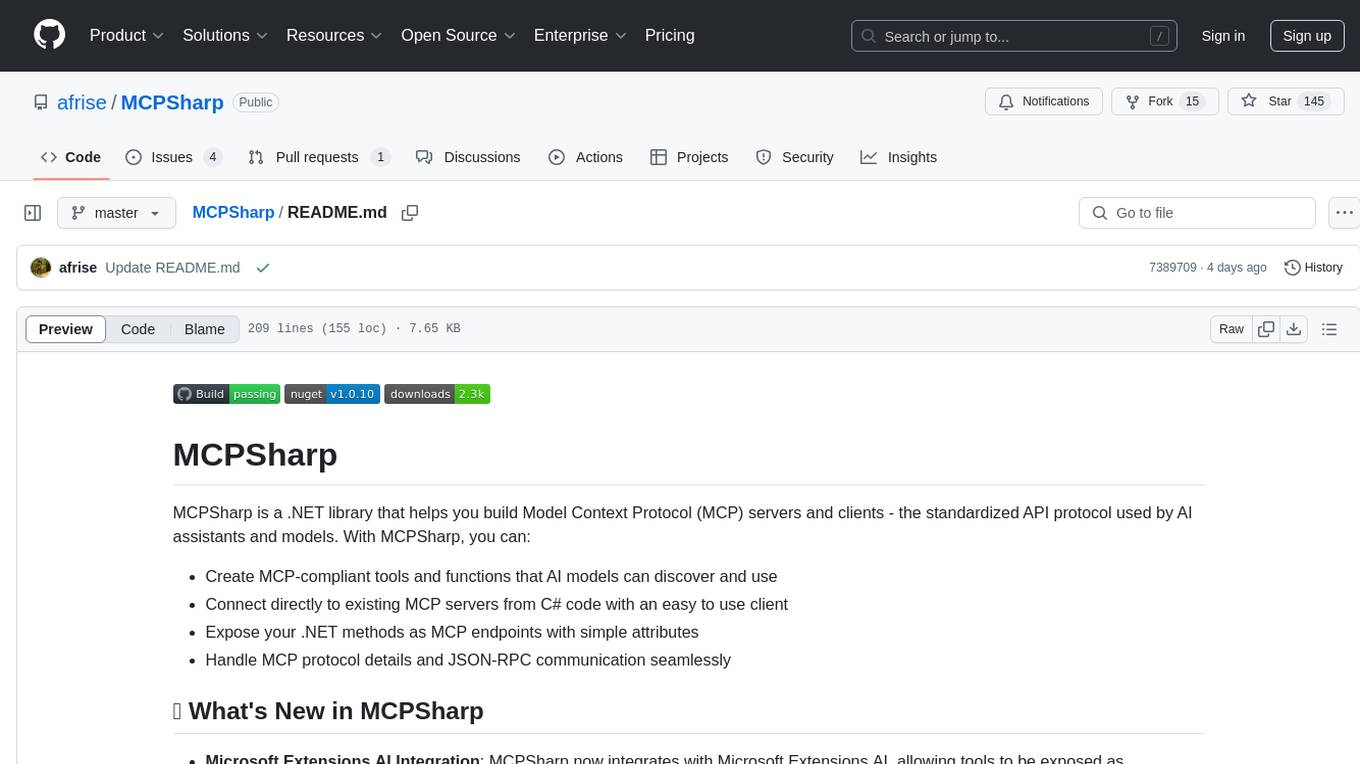
MCPSharp
MCPSharp is a .NET library that helps build Model Context Protocol (MCP) servers and clients for AI assistants and models. It allows creating MCP-compliant tools, connecting to existing MCP servers, exposing .NET methods as MCP endpoints, and handling MCP protocol details seamlessly. With features like attribute-based API, JSON-RPC support, parameter validation, and type conversion, MCPSharp simplifies the development of AI capabilities in applications through standardized interfaces.
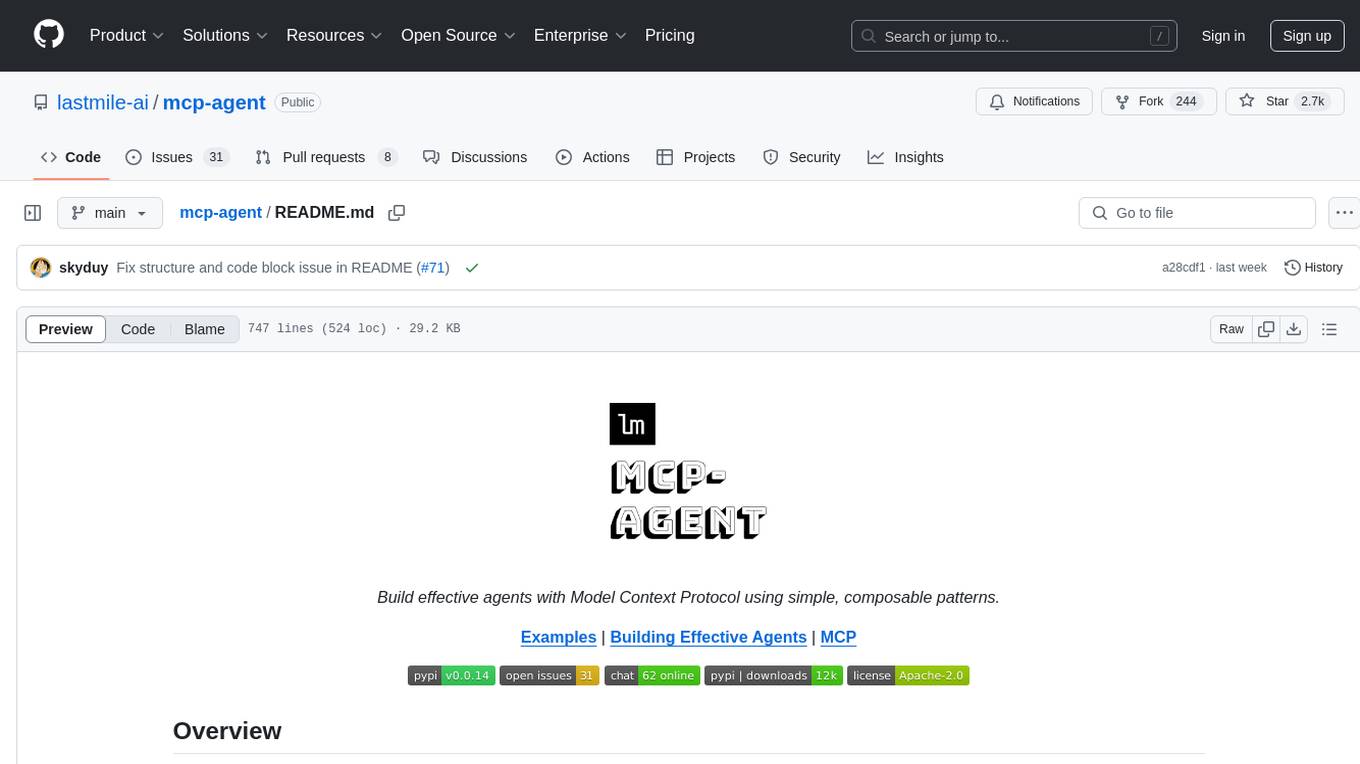
mcp-agent
mcp-agent is a simple, composable framework designed to build agents using the Model Context Protocol. It handles the lifecycle of MCP server connections and implements patterns for building production-ready AI agents in a composable way. The framework also includes OpenAI's Swarm pattern for multi-agent orchestration in a model-agnostic manner, making it the simplest way to build robust agent applications. It is purpose-built for the shared protocol MCP, lightweight, and closer to an agent pattern library than a framework. mcp-agent allows developers to focus on the core business logic of their AI applications by handling mechanics such as server connections, working with LLMs, and supporting external signals like human input.

rl
TorchRL is an open-source Reinforcement Learning (RL) library for PyTorch. It provides pytorch and **python-first** , low and high level abstractions for RL that are intended to be **efficient** , **modular** , **documented** and properly **tested**. The code is aimed at supporting research in RL. Most of it is written in python in a highly modular way, such that researchers can easily swap components, transform them or write new ones with little effort.
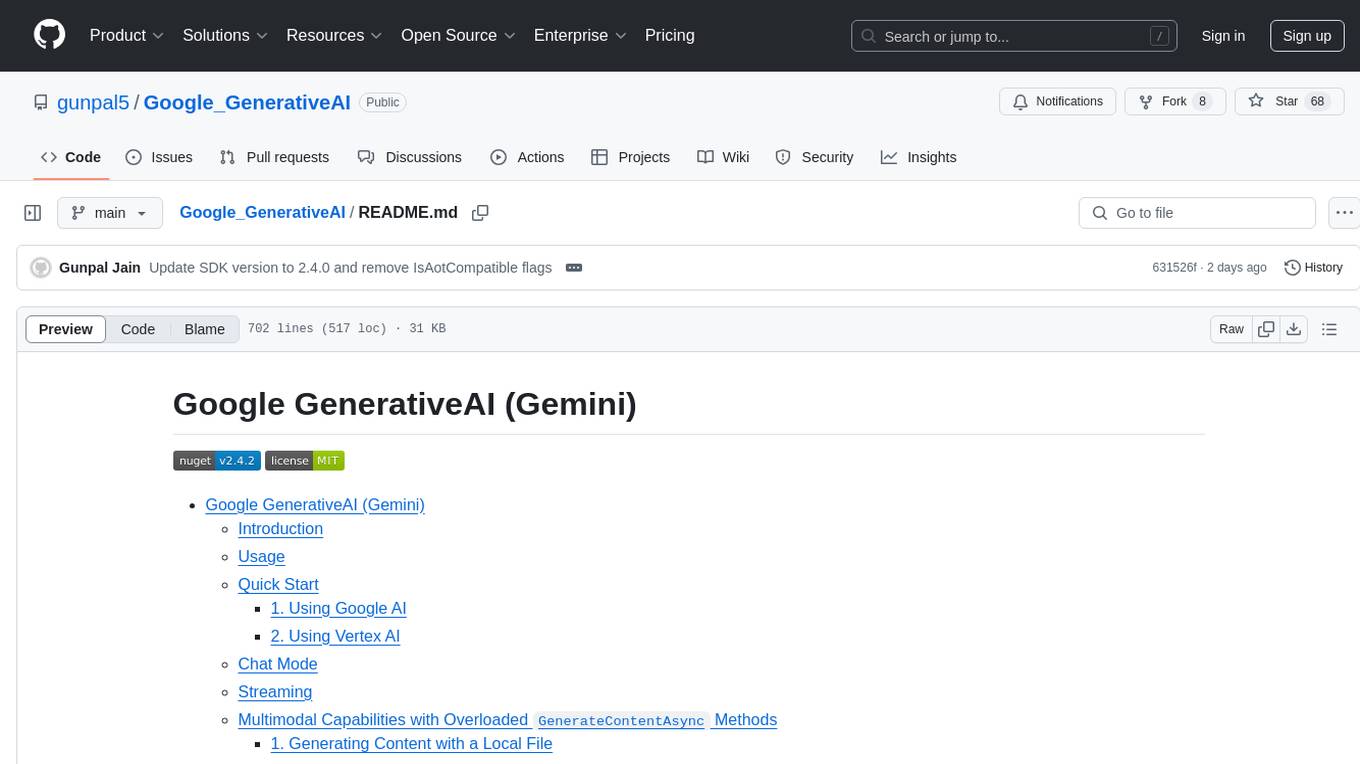
Google_GenerativeAI
Google GenerativeAI (Gemini) is an unofficial C# .Net SDK based on REST APIs for accessing Google Gemini models. It offers a complete rewrite of the previous SDK with improved performance, flexibility, and ease of use. The SDK seamlessly integrates with LangChain.net, providing easy methods for JSON-based interactions and function calling with Google Gemini models. It includes features like enhanced JSON mode handling, function calling with code generator, multi-modal functionality, Vertex AI support, multimodal live API, image generation and captioning, retrieval-augmented generation with Vertex RAG Engine and Google AQA, easy JSON handling, Gemini tools and function calling, multimodal live API, and more.
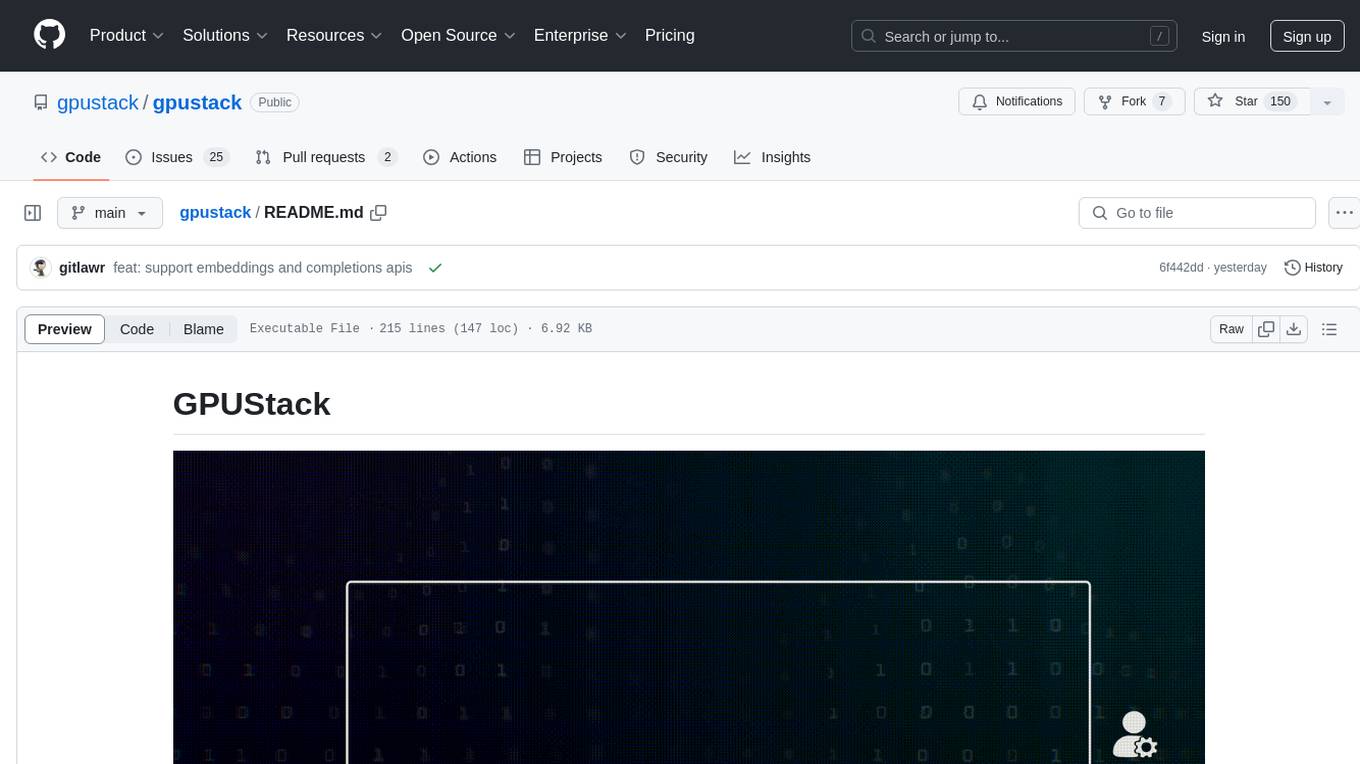
gpustack
GPUStack is an open-source GPU cluster manager designed for running large language models (LLMs). It supports a wide variety of hardware, scales with GPU inventory, offers lightweight Python package with minimal dependencies, provides OpenAI-compatible APIs, simplifies user and API key management, enables GPU metrics monitoring, and facilitates token usage and rate metrics tracking. The tool is suitable for managing GPU clusters efficiently and effectively.
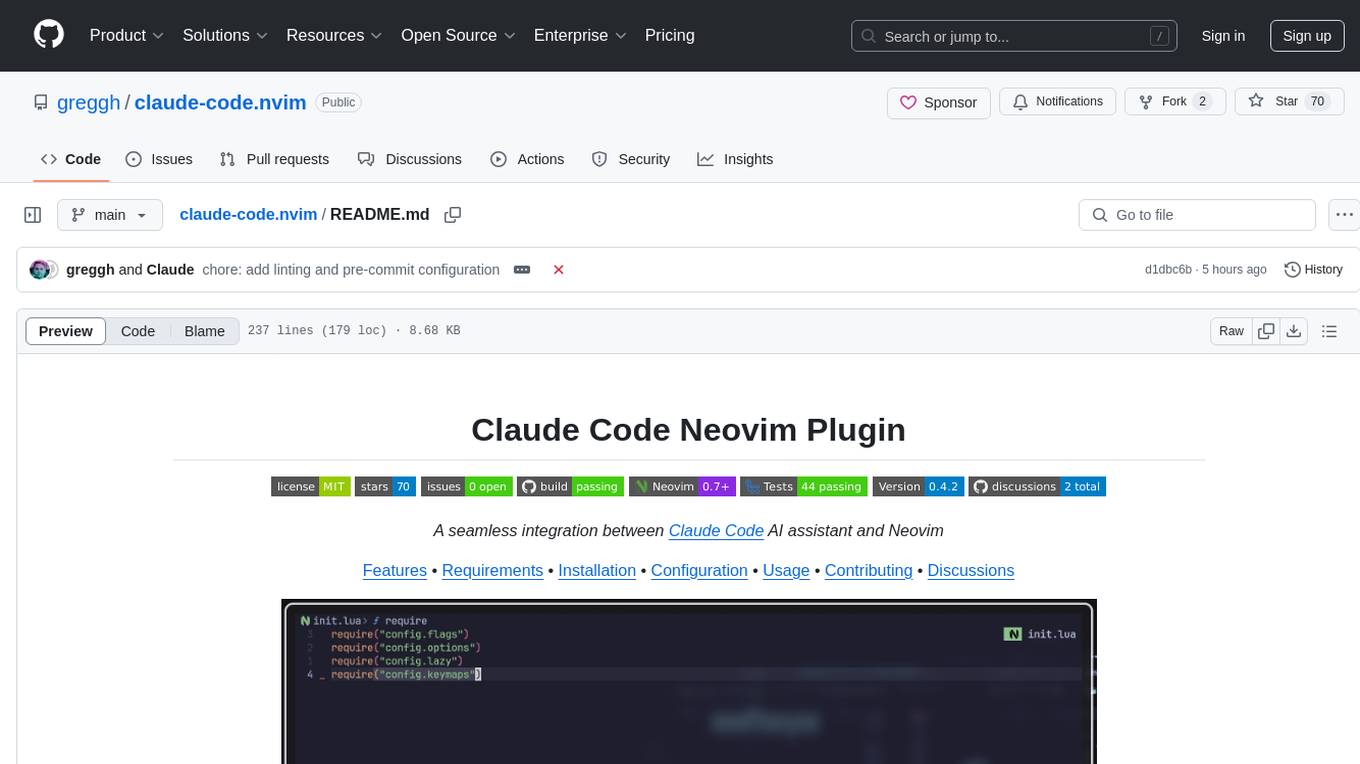
claude-code.nvim
Claude Code Neovim Plugin is a seamless integration between Claude Code AI assistant and Neovim. It allows users to toggle Claude Code in a terminal window with a single key press, automatically detect and reload files modified by Claude Code, provide real-time buffer updates when files are changed externally, offer customizable window position and size, integrate with which-key, use git project root as working directory, maintain a modular code structure, provide type annotations with LuaCATS for better IDE support, offer configuration validation, and include a testing framework for reliability. The plugin creates a terminal buffer running the Claude Code CLI, sets up autocommands to detect file changes on disk, automatically reloads files modified by Claude Code, provides keymaps and commands for toggling the terminal, and detects git repositories to set the working directory to the git root.
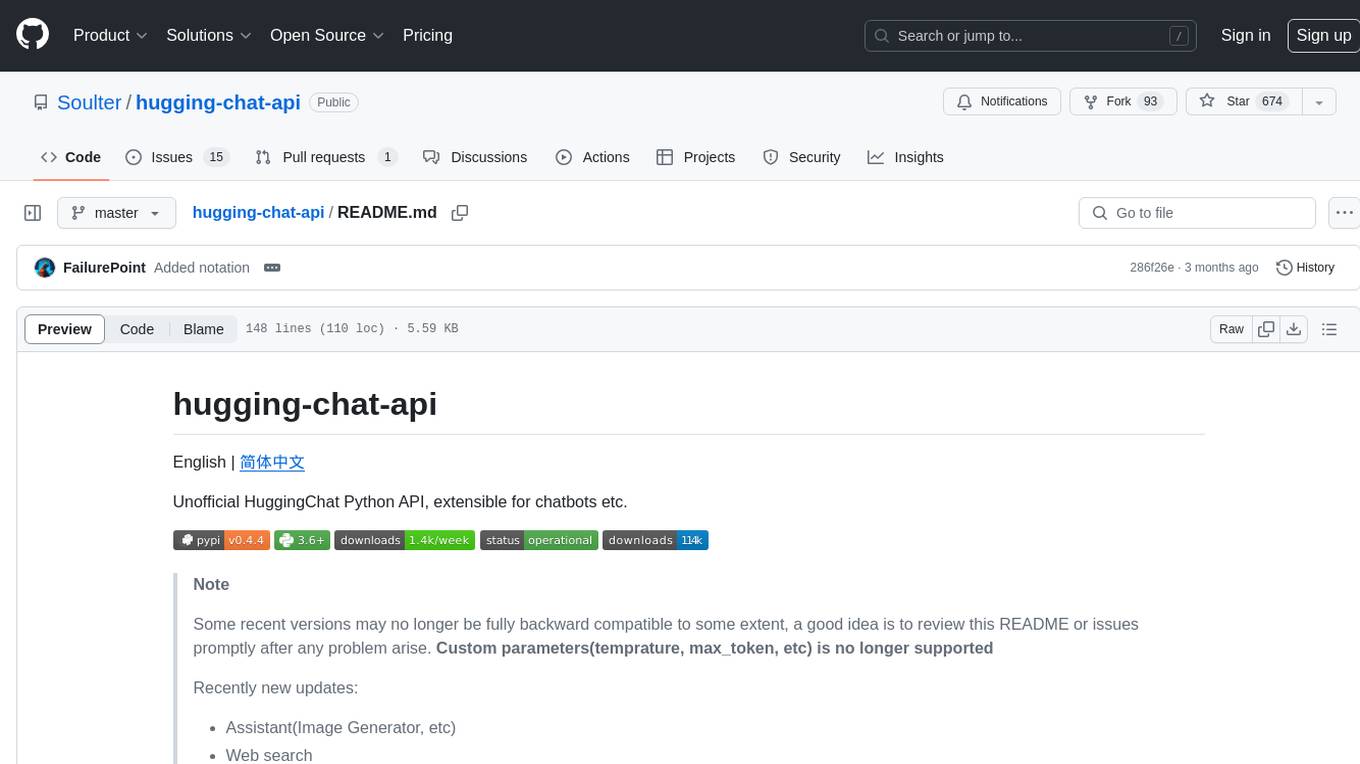
hugging-chat-api
Unofficial HuggingChat Python API for creating chatbots, supporting features like image generation, web search, memorizing context, and changing LLMs. Users can log in, chat with the ChatBot, perform web searches, create new conversations, manage conversations, switch models, get conversation info, use assistants, and delete conversations. The API also includes a CLI mode with various commands for interacting with the tool. Users are advised not to use the application for high-stakes decisions or advice and to avoid high-frequency requests to preserve server resources.
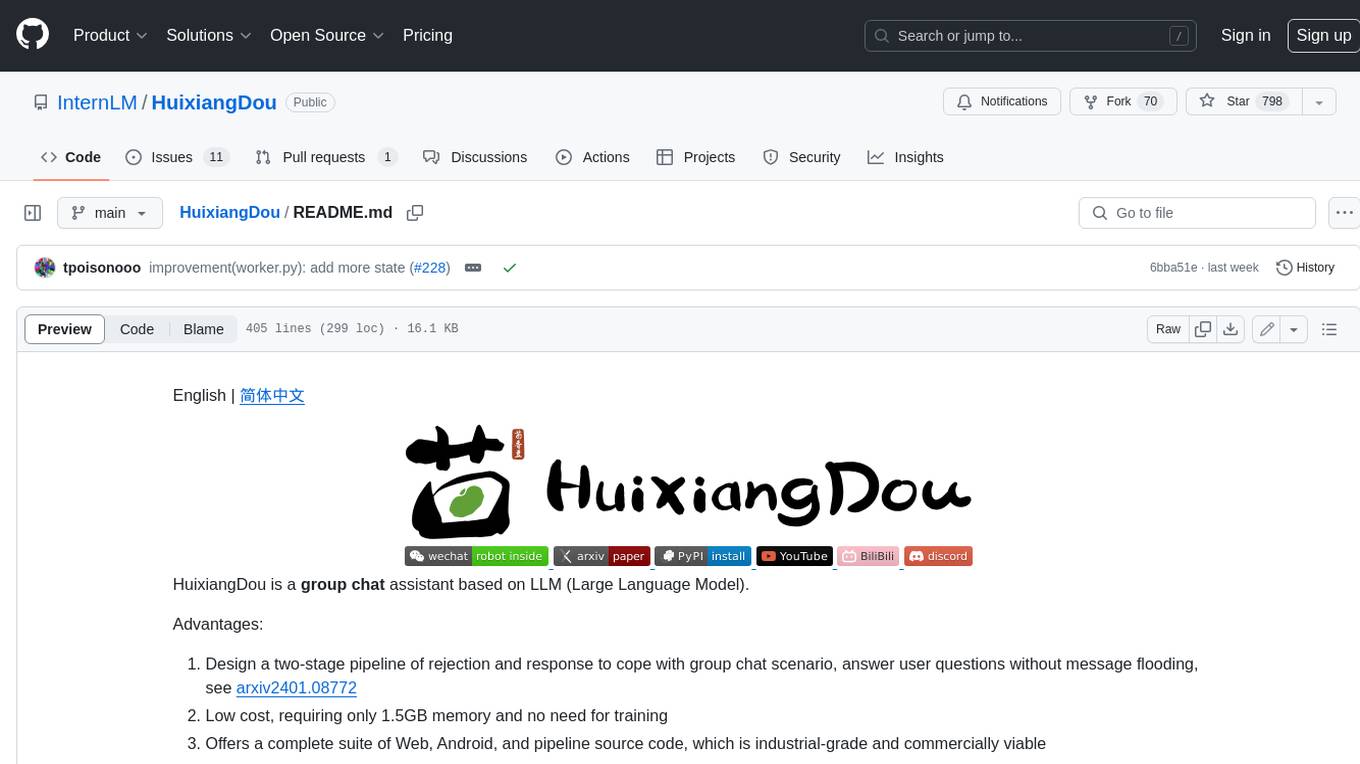
HuixiangDou
HuixiangDou is a **group chat** assistant based on LLM (Large Language Model). Advantages: 1. Design a two-stage pipeline of rejection and response to cope with group chat scenario, answer user questions without message flooding, see arxiv2401.08772 2. Low cost, requiring only 1.5GB memory and no need for training 3. Offers a complete suite of Web, Android, and pipeline source code, which is industrial-grade and commercially viable Check out the scenes in which HuixiangDou are running and join WeChat Group to try AI assistant inside. If this helps you, please give it a star ⭐
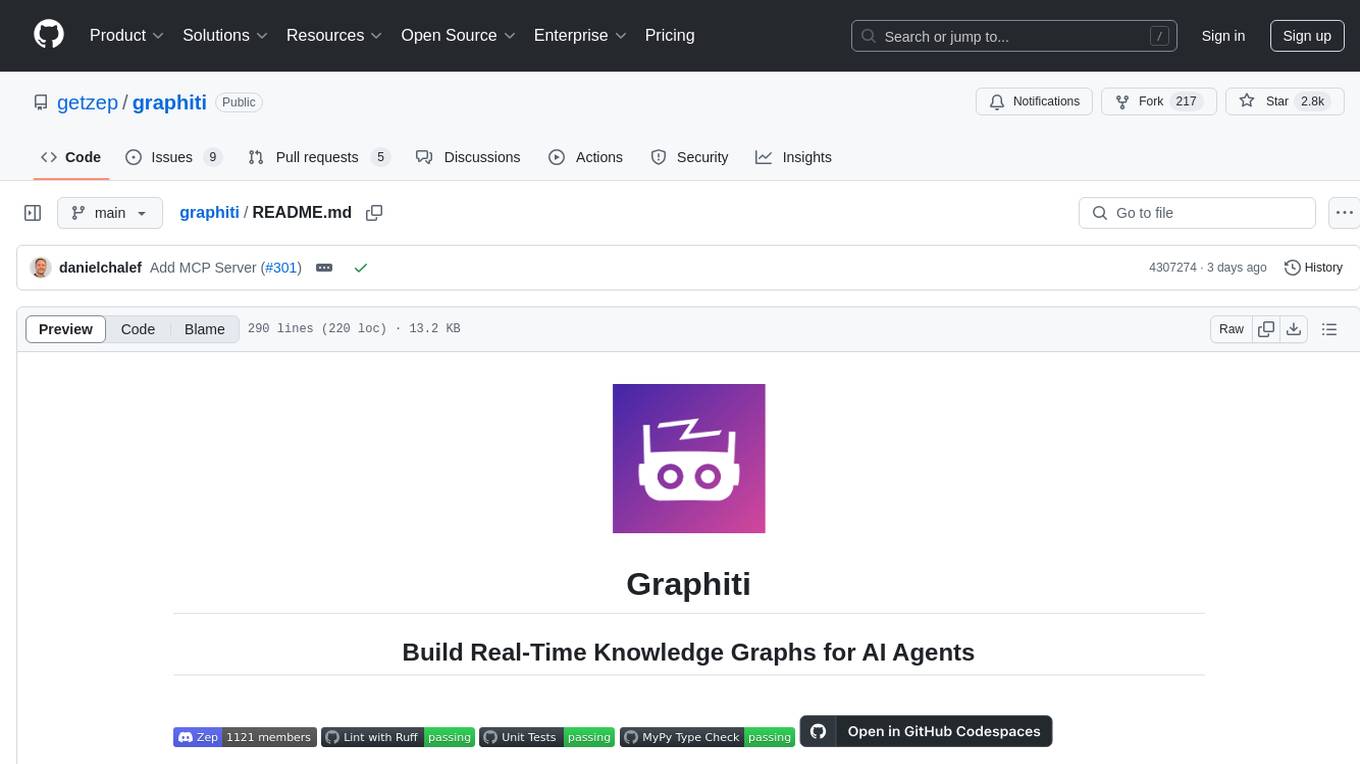
graphiti
Graphiti is a framework for building and querying temporally-aware knowledge graphs, tailored for AI agents in dynamic environments. It continuously integrates user interactions, structured and unstructured data, and external information into a coherent, queryable graph. The framework supports incremental data updates, efficient retrieval, and precise historical queries without complete graph recomputation, making it suitable for developing interactive, context-aware AI applications.
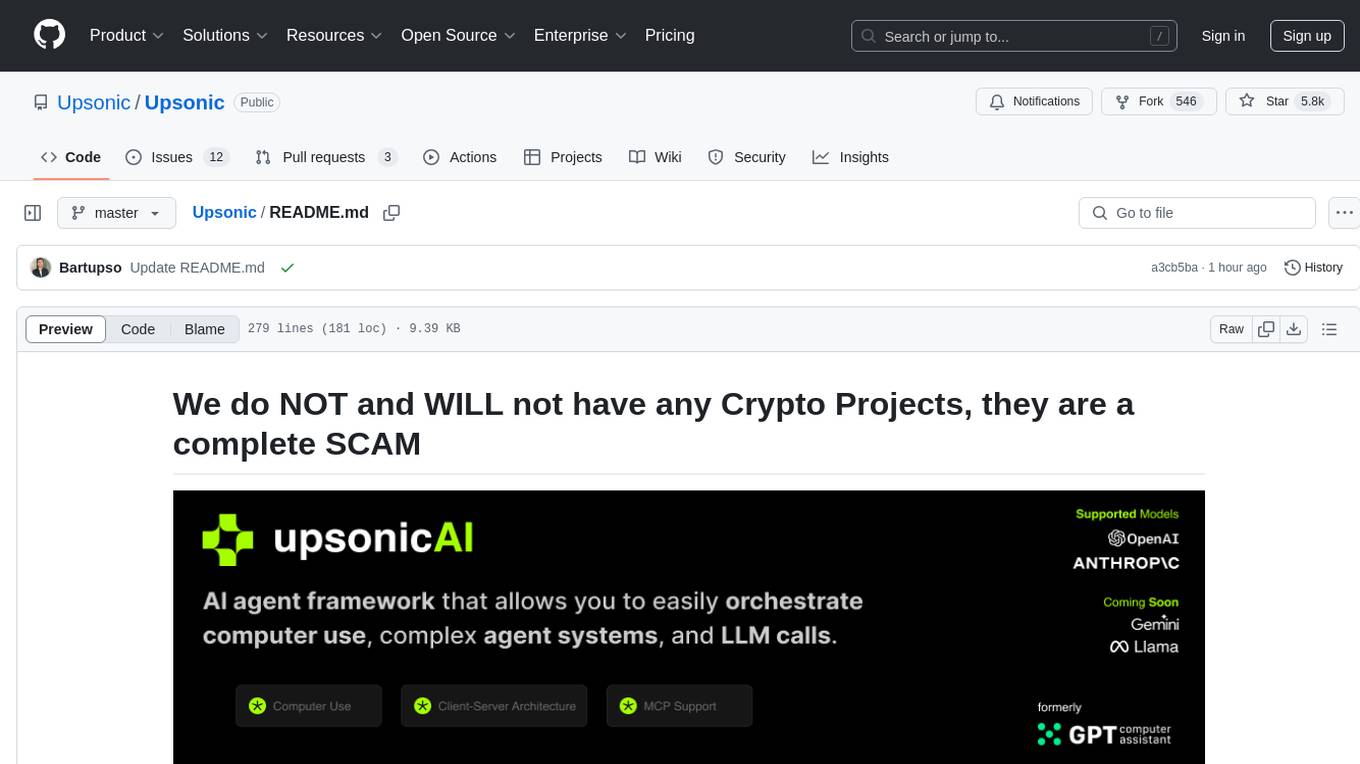
gpt-computer-assistant
GPT Computer Assistant (GCA) is an open-source framework designed to build vertical AI agents that can automate tasks on Windows, macOS, and Ubuntu systems. It leverages the Model Context Protocol (MCP) and its own modules to mimic human-like actions and achieve advanced capabilities. With GCA, users can empower themselves to accomplish more in less time by automating tasks like updating dependencies, analyzing databases, and configuring cloud security settings.
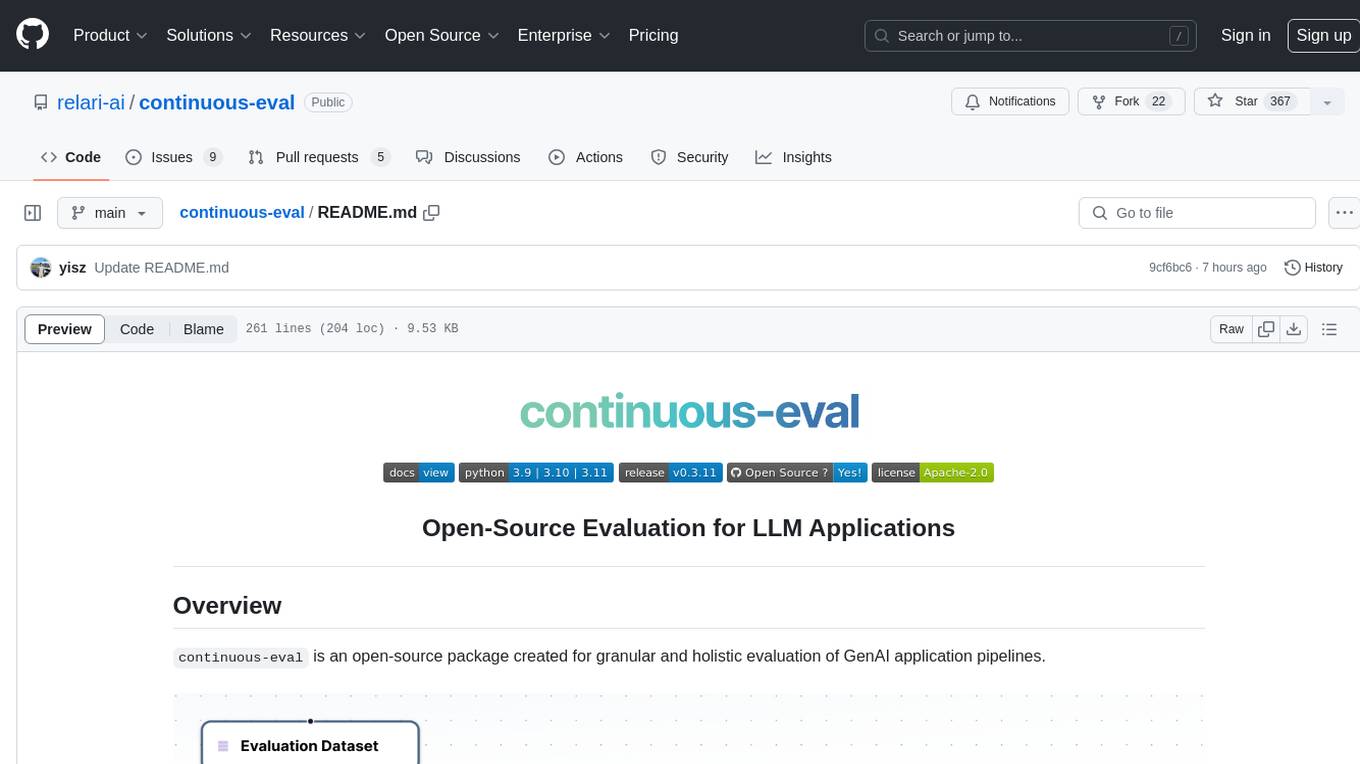
continuous-eval
Open-Source Evaluation for LLM Applications. `continuous-eval` is an open-source package created for granular and holistic evaluation of GenAI application pipelines. It offers modularized evaluation, a comprehensive metric library covering various LLM use cases, the ability to leverage user feedback in evaluation, and synthetic dataset generation for testing pipelines. Users can define their own metrics by extending the Metric class. The tool allows running evaluation on a pipeline defined with modules and corresponding metrics. Additionally, it provides synthetic data generation capabilities to create user interaction data for evaluation or training purposes.
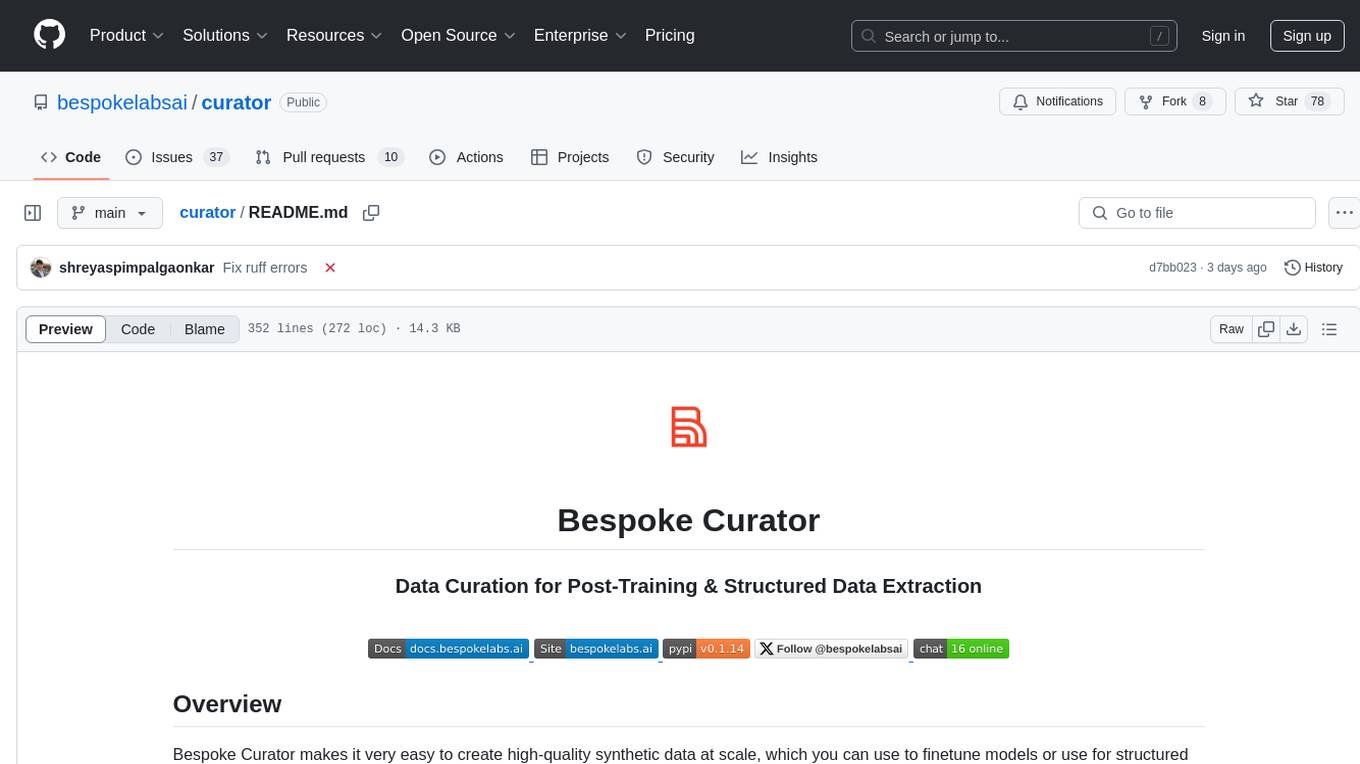
curator
Bespoke Curator is an open-source tool for data curation and structured data extraction. It provides a Python library for generating synthetic data at scale, with features like programmability, performance optimization, caching, and integration with HuggingFace Datasets. The tool includes a Curator Viewer for dataset visualization and offers a rich set of functionalities for creating and refining data generation strategies.
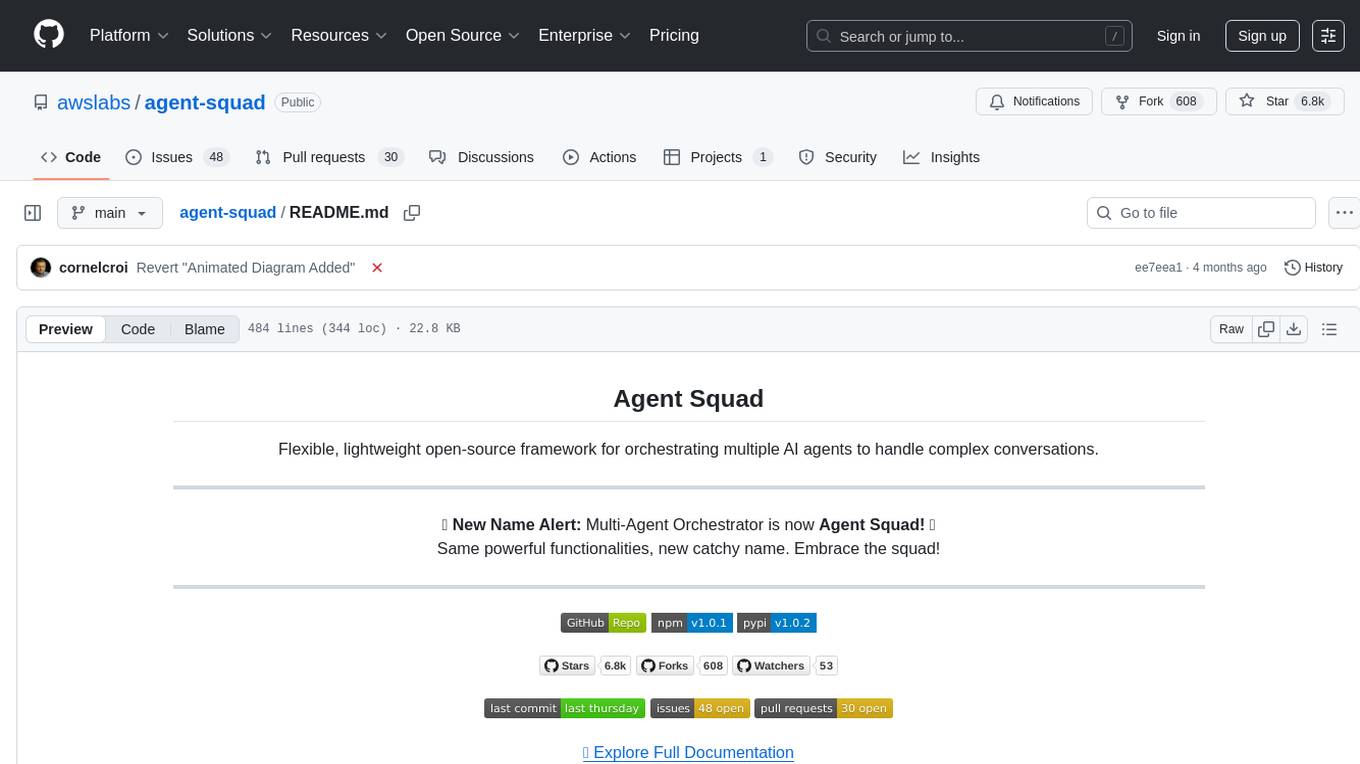
agent-squad
Agent Squad is a flexible, lightweight open-source framework for orchestrating multiple AI agents to handle complex conversations. It intelligently routes queries, maintains context across interactions, and offers pre-built components for quick deployment. The system allows easy integration of custom agents and conversation messages storage solutions, making it suitable for various applications from simple chatbots to sophisticated AI systems, scaling efficiently.

multi-agent-orchestrator
Multi-Agent Orchestrator is a flexible and powerful framework for managing multiple AI agents and handling complex conversations. It intelligently routes queries to the most suitable agent based on context and content, supports dual language implementation in Python and TypeScript, offers flexible agent responses, context management across agents, extensible architecture for customization, universal deployment options, and pre-built agents and classifiers. It is suitable for various applications, from simple chatbots to sophisticated AI systems, accommodating diverse requirements and scaling efficiently.
For similar tasks

langgraph4j
LangGraph for Java is a library designed for building stateful, multi-agent applications with LLMs. It is a porting of the original LangGraph from the LangChain AI project to Java. The library allows users to define agent states, nodes, and edges in a graph structure to create complex workflows. It integrates with LangChain4j and provides tools for executing actions based on agent decisions. LangGraph for Java enables users to create asynchronous node actions, conditional edges, and normal edges to model decision-making processes in applications.
For similar jobs

sweep
Sweep is an AI junior developer that turns bugs and feature requests into code changes. It automatically handles developer experience improvements like adding type hints and improving test coverage.

teams-ai
The Teams AI Library is a software development kit (SDK) that helps developers create bots that can interact with Teams and Microsoft 365 applications. It is built on top of the Bot Framework SDK and simplifies the process of developing bots that interact with Teams' artificial intelligence capabilities. The SDK is available for JavaScript/TypeScript, .NET, and Python.

ai-guide
This guide is dedicated to Large Language Models (LLMs) that you can run on your home computer. It assumes your PC is a lower-end, non-gaming setup.

classifai
Supercharge WordPress Content Workflows and Engagement with Artificial Intelligence. Tap into leading cloud-based services like OpenAI, Microsoft Azure AI, Google Gemini and IBM Watson to augment your WordPress-powered websites. Publish content faster while improving SEO performance and increasing audience engagement. ClassifAI integrates Artificial Intelligence and Machine Learning technologies to lighten your workload and eliminate tedious tasks, giving you more time to create original content that matters.

chatbot-ui
Chatbot UI is an open-source AI chat app that allows users to create and deploy their own AI chatbots. It is easy to use and can be customized to fit any need. Chatbot UI is perfect for businesses, developers, and anyone who wants to create a chatbot.

BricksLLM
BricksLLM is a cloud native AI gateway written in Go. Currently, it provides native support for OpenAI, Anthropic, Azure OpenAI and vLLM. BricksLLM aims to provide enterprise level infrastructure that can power any LLM production use cases. Here are some use cases for BricksLLM: * Set LLM usage limits for users on different pricing tiers * Track LLM usage on a per user and per organization basis * Block or redact requests containing PIIs * Improve LLM reliability with failovers, retries and caching * Distribute API keys with rate limits and cost limits for internal development/production use cases * Distribute API keys with rate limits and cost limits for students

uAgents
uAgents is a Python library developed by Fetch.ai that allows for the creation of autonomous AI agents. These agents can perform various tasks on a schedule or take action on various events. uAgents are easy to create and manage, and they are connected to a fast-growing network of other uAgents. They are also secure, with cryptographically secured messages and wallets.

griptape
Griptape is a modular Python framework for building AI-powered applications that securely connect to your enterprise data and APIs. It offers developers the ability to maintain control and flexibility at every step. Griptape's core components include Structures (Agents, Pipelines, and Workflows), Tasks, Tools, Memory (Conversation Memory, Task Memory, and Meta Memory), Drivers (Prompt and Embedding Drivers, Vector Store Drivers, Image Generation Drivers, Image Query Drivers, SQL Drivers, Web Scraper Drivers, and Conversation Memory Drivers), Engines (Query Engines, Extraction Engines, Summary Engines, Image Generation Engines, and Image Query Engines), and additional components (Rulesets, Loaders, Artifacts, Chunkers, and Tokenizers). Griptape enables developers to create AI-powered applications with ease and efficiency.


